What’s more, which measures are affecting this development?
In the introductory post of our blog series “Agile Empowerment,” we portrayed the commonplace difficulties en route to agile change and the critical inquiry of why a manager’s attitude is the way to progress. The subsequent article examined why “Servant Leadership” is vital as an authority style for an agile change, how it contrasts from conventional administration, and what assumptions representatives have of managers in an elegant climate.
In the last post of our article series, we diagram a roadmap of some signs your agile testing is not that agile.
Robust and agile leadership can be learned; however, why do many chiefs think it is hard to go about as servant pioneers?
Fortunately, servant leadership can be learned. However, neither individual preparation nor individual coaching sessions are sufficient for this. Maybe, it is a ceaseless development measure that requires escalated self-reflection and standard coaching.
The establishment of a servant chief requires a strong WHY and an unmistakably characterized HOW
The self-improvement interaction of a manager goes connected at the hip with the agile change of an organization. It’s about a change venture on two levels: personally and organizationally.
Yet, how would you begin the most common way of turning into a servant chief?
What are the central components of this development cycle?
There is practically nothing more troublesome than changing one’s behavior and the associated mentality, that is, one’s inward disposition and demeanor. The ideal change regularly fizzles because the accompanying inquiries can’t be replied to at all or just deficiently:
- Which characteristics should be disposed of and which ones to create?
- How would I foster the essential new leadership abilities?
- How would I foster the boldness to withstand headwinds, to permit mistakes (personally, just as with employees)?
- How would I figure out how to frame strong alliances and get employees ready?
However, it is precisely these inquiries or the responses to them that are unmistakable for progress.
It is fundamental for a fruitful transformation excursion of managers to be organized all along and joined by capable and ceaseless coaching and preparation. The necessary period relies upon the outlook, the transparency, and the desire of a manager, just as the organizational development level concerning the legalization of an organization. The suggested, steady help can consequently reach out from a half year to longer than a year and even past. Our undertaking experience has shown that the transformation cycle should cover the accompanying three focal transformations that must be executed in the short, medium, and long periods.
A significant piece of the interaction centers on creating and growing servant leadership characteristics. Explicit mindset pieces of training assist managers with getting what servant leadership fundamentally means and which individual parts and abilities should be developed.
Simultaneously, blended training and studios ought to be held with managers and employees. This has a few beneficial outcomes: On the one hand, managers can apply the information they have gained from mindset training straightforwardly, check it, and improve iteratively. Then again, the employees are included right from the beginning. This gives them a quicker and better comprehension of the forthcoming changes and the comparing space for adjusting their mindset.
Contrasted with the administration training, these exceptionally intuitive trainings are done longer with the help of a mentor to guarantee enduring changes in the organization. The activities are supported by compelling and consistently carried out input designs. These give all-around established substance to empower continuous improvement and to learn for all interested parties. To expand acknowledgment and, along these lines, the viability of outside mentors, we suggest getting them on board directly toward the beginning of a transformation venture. Along these lines, they can develop a strong premise of trust, are viewed as inborn individuals from the transformation cycle, and are in this way ready to lead intensive consultations.
Which key questions and formats are incredibly successful in accomplishing the goal?
On a basic level, detailed vital questions can be relegated to every one of the three branches of knowledge, which are then replied to with the assistance of chose strategies and training formats. As portrayed in the past segment, the work and level of detail rely upon the objective picture just as the organizational development or group of readiness toward the beginning. It is significant that a perfectly tuned training and change idea is created and afterward executed consistently – this is the best way to live the WHY and the HOW in the long haul.
We suggest showing managers the (Why/Purpose [1]) in the primary transformation stage.
The leaders give the organization and their teams the underlying catalyst to acknowledge changes and present them sustainably. The more persuaded they are themselves, the earnestly persuading they can act in their excellent example capacity to the rest of the world. A fit-hole examination is utilized to distinguish existing or created abilities and characteristics according to servant leadership. In the secured space of individual coaching, managers can bargain all the more intensively and all the more unreservedly with personal attitude and behavior changes and execute them on a trial premise.
In the second transformation stage, the emphasis is on the communications between teams, just as teams and their managers in an elegant setting. Common assumptions are characterized, expressed, and explicit spaces of use are recognized and, if fundamental, staged. Our venture experience has affirmed that the execution pace of learned information is expanded through the mix of explicit group training and blended group and board training. The outcome ought to be a typical, clear comprehension of why something should change, what explicitly needs to change, and how it is achieved. This guarantees that everybody is ready and effectively adds to the changes.
In the last transformation stage, criticism or an articulated input culture should turn into a usual result. With an underlying pattern or zero estimation, progress can be distinguished and appropriately perceived without much of a stretch (celebrating is permitted). Criticism can be acquired namelessly utilizing purported beat checks [2], just as indirect trade, for instance, regarding customary reviews. They structure the reason for the joint development and prioritization of improvement measures and the limiting execution.
Be practical! Optimistic and Motivated!
Significant change isn’t something that occurs incidentally. It takes personal self-discipline, persistence, and grit to go to an agile perspective and work. With the essential discipline, sooner or later, the intentionally applied standards of behavior become new schedules – autopilots – that assist you with exploring quickly in an agile climate. Then, at that
the point you will be reimbursed at the most recent – with expanded worker fulfillment and inspiration, boosted group efficiency, and extended nature of results through to more extraordinary inventiveness and advancement.
Our conclusion: Servant leadership ought not to stay a popular expression – it is neither too frail nor excessively delicate and can be learned and carried out by chiefs with the assistance of the proper methodology and the right attitude.
When will you harvest the products of servant leadership and agile work? If you are looking for the best agile services, you are at the right website, we are here for your agile development because, in the end, we are making IT happen for you.
Feel free to contact us at info@ahdustechnology.com


